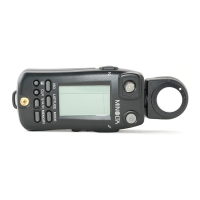For flash light measurement, the Flash Meter VI uses a method of
measuring flash light/ambient light separately.
The proportion of ambient light and flash light to the total exposure is
indicated on the quadrant analyze scale.
How to read the flash/ambient light ratio
Whenever you take a flash light reading, the
analyze scale is displayed on the LCD data
panel. After a reading, you can also do a
simulation to see how changes to the shutter
speed affect the proportions of ambient light and
flash light.
The analyze scale shows the proportion of flash
light in the total exposure reading as one of five
levels.
Example of reading, display and simulation
Assume that a tungsten lamp is used as the ambient light source.
●● Reading of F2.8
0 at a shutter speed of 1/60 sec.
Two quadrants are lit up on the display, indicating
that the proportion of flash light is approx. 50%
(ambient:flash ratio =1:1).
A photograph taken under these conditions will not be strongly influenced
by either the tungsten light (orange) or the flash light (white).
E37
Basic Operation
E36
Basic Operation
●● Using the up/down dial to change the shutter speed to 1/15, we can see
how this change will affect the mix of ambient and flash light.
The aperture has changed to F4.0
3 and now, only
one quadrant is lit up. This indicates that the
proportion of flash light is now only 25%
(ambient:flash ratio =3:1).
A photograph taken under these conditions will
be influenced more strongly by the tungsten light
(orange) and less strongly by the flash light
(white).
On the other hand, increasing the shutter speed (within the range of sync)
will have the opposite effect-photos will be more strongly influenced by
flash light (white) than ambient light.
This simulation is based on controlling the ambient light by varying the
shutter speed. The proportions of ambient light and flash light can also be
adjusted by changing the intensity of the flash light.
The intensity of flash light can be controlled either by varying the distance
between the subject and the flash, or by changing the power (light output)
of the flash.
When you are controlling flash light intensity, you must take a new reading
each time one of these two factors is changed.
Light Ratio Analyze function

